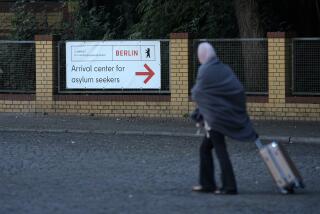Upcoming Euro Change Has Germans Rolling in Old Dough
- Share via
BERLIN — As European banks prepare for next year’s arrival of euro bills and coins, they know there are lots of people out there like Jutta and Rudi.
The retired German couple recently trundled into the Sparkasse bank on Alexanderplatz, unzipped the two wheeled suitcases they were dragging and plunked down 17 giant plastic freezer bags filled with coins.
No one was more surprised than they were to learn that the money they had collected in jars, drawers and pockets over the years was worth nearly $5,000--a sum now safely in their savings account, with no charge for the counting or rolling.
“People seem eager to do what they can to avoid a big crush at the end of the year,” Volker Winde, spokesman for the 170 Sparkasse branches in Berlin, said of the bank’s appeal to customers to bring in what Germans call their “sleeping money” early.
Germany is one of 12 European Union states that will swap their national bills and coins for the euro common currency Jan. 1. But as the most populous country in Euroland and one that has been using the same money since 1948, Germany has a volume of coins in circulation that is incalculable but certainly staggering.
Since the deutsche mark was introduced 53 years ago, 48 billion coins have been minted, according to the Finance Ministry. That’s 585 coins for every man, woman and child in the country, a volume unlikely to be moving about daily in purses and pockets.
The Finance Ministry estimates that only about 60% of the coin cash produced over the years will be surrendered for new euros and cents, with the rest having been lost to collectors, costume jewelers, sewer grates or wishing wells.
Still, the 28 billion coins the ministry is counting on coming back by the end of the year represent a considerable piece of change. At 108,000 tons, they could fill 4,200 moving vans, said Gunnar John, the Finance Ministry official responsible for euro conversion issues.
New euro coins are already being minted and stored for December distribution at a former military barracks in the Berlin suburb of Wedding. They will go on sale two weeks before the euro becomes legal tender.
To avoid as much confusion as possible during the two months next year when both deutsche marks and euros will be in circulation, banks are calling on their customers to clean out their closets and piggy banks of all schlafmuenzen--sleeping coins.
Most banks are offering sacks for rounding up the loose change and are doing the counting and rolling for free. In return, customers such as the Berlin couple, who declined to give their last name for fear burglars would think they have even more money stashed at home, get the sum credited to their savings accounts or cashed out in deutsche mark bills.
The logistical challenge of swapping out such a huge volume of coins is being exaggerated, John said. But what is daunting, he admitted, is storing the excess cash and then invalidating each and every mark and pfennig once it is pulled out of circulation.
That job has been handed over to an outfit experienced in getting rid of heavy metal--the army’s subsidiary that scraps old tanks, transports and other hardware.
Vebeg, as the army demolition experts are known, will first have to deform each of the surrendered coins to prevent its being taken from storage and presented for exchange with the euro.
“Then we’ll have to melt them down and sell the bulk as scrap metal,” Vebeg spokesman Uwe Uhlemann said. He acknowledged that he has no clue how the availability of such huge volumes of copper, nickel and steel will affect the secondhand metals markets but said he assumes higher minds will by then have a plan to avoid a glut.
While the bean counters and demolition experts are still scratching their heads over how to deal with the metal inundation, the creative sector of German society is also hunting for solutions.
Artist Susanne Bosch has erected a giant, glass-fronted shipping container in the pedestrian core of Alexanderplatz and another at Munich’s central Marienplatz with an appeal for every passerby to toss in a spare pfennig. That’s the smallest of the seven German coins due for euro replacement, each about the diameter of an aspirin, wafer-thin and worth less than half a U.S. penny.
“I’m also collecting ideas on what to do with the money,” said Bosch, who has a separate box for messages at the collection-cum-exhibit as well as a Web site for suggestions at www.restpfennig.com.
Many have advised giving the money to charity or financing a study grant. But a sizable number have urged Bosch to transform them into some artistic monument to the disappearing currency that remains dear to most Germans.
A committee of art activists will decide what to do with the coins by the end of the year, Bosch said, estimating that the container already holds about 3 million pfennigs, worth about $13,000.
The glass on the collection box is reinforced and the steel container is locked, but Bosch said she isn’t worried about thieves making off with her bounty.
“It wouldn’t pay to steal it--it’s too heavy,” she said. “And that’s part of the idea of the exhibit, that you really have to think about what you can do with just pfennigs.”
More to Read
Sign up for Essential California
The most important California stories and recommendations in your inbox every morning.
You may occasionally receive promotional content from the Los Angeles Times.














